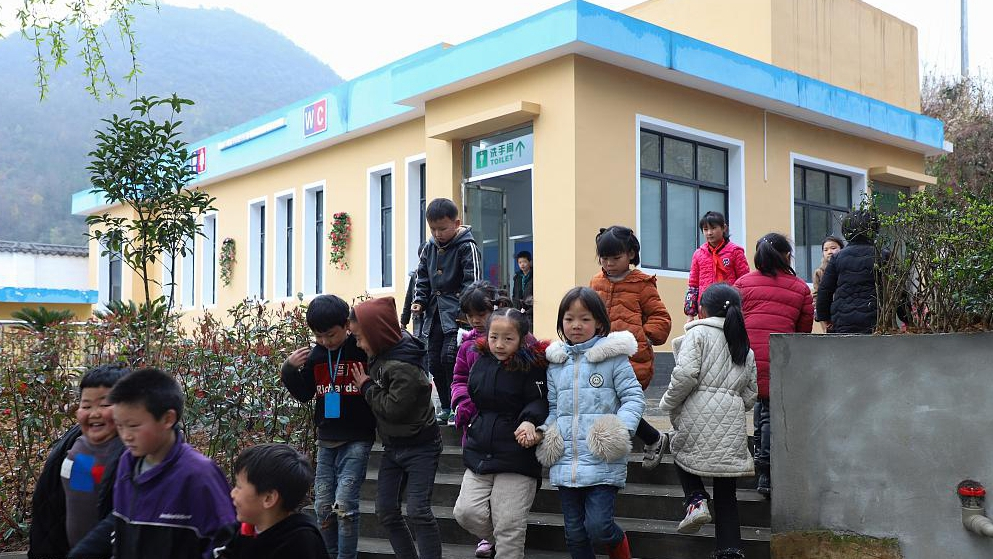
Opinion
08:08, 08-Mar-2019
Is China's poverty reduction too good to be true?
Updated
13:59, 08-Mar-2019
Hannah Ryder

Editor's note: Hannah Ryder is the CEO of Development Reimagined, an international development consultancy based in Beijing. The article reflects the author's opinion, and not necessarily the views of CGTN.
If there are any two numbers that should stick in your mind this week with regards to China, it's 13.9 million and 500 million. Why? 13.9 million refers to the number of people in rural areas in China who, according to government figures released, were supported to lift themselves out of poverty this year, leaving 16.6 million still living in absolute poverty in the country, or on less than one U.S. dollar a day (NB: The World Bank definition of absolute poverty is 1.90 U.S. dollars a day). 500 million, on the other hand, is a projection of the number of middle-class consumers in China by 2022.
The contrast between these two numbers illustrates facts about China that many who come to China's big cities like Beijing and Shanghai for the first time are astounded by. Due to high rates of economic growth – driven by government investment in manufacturing capability, infrastructure and education in particular – on its current trajectory of five percent growth or more, the average Chinese person is expected to have an income of at least 12,055 U.S. dollars per year by 2024, joining other developing countries such as Panama in the "high-income" country category.
Indeed, by China's definition of absolute poverty, the country is also on track to totally eliminate rural poverty by 2020 – contributing to meeting global UN targets known as the "Sustainable Development Goals."
Supporting 13.9 million people to raise their incomes is no mean feat. That's larger than the entire population of, say, Rwanda in Africa, or Cuba in the Caribbean. Nigeria – Africa's most populous country – is projected to still have over 110 million people in extreme poverty as late as 2030.

Pingdongkou Village in Yinjiang Tujia Autonomous County in China's southwestern Guizhou Province on the morning of August 29, 2018. /VCG Photo
Pingdongkou Village in Yinjiang Tujia Autonomous County in China's southwestern Guizhou Province on the morning of August 29, 2018. /VCG Photo
Concentrating on the World Bank's 1.90 U.S. dollars a day definition of extreme poverty, there is a fascinating web tool called the World Poverty Clock which suggests that for all developing countries from 2017 to 2018 – including China – 16 million people lifted themselves over that poverty line.
Because China and the World Bank have slightly different definitions of poverty, it is difficult to marry all the different figures together. But even if we cut the total figure of Chinese people who escaped from poverty in half that year (to account for the fact that China's poverty line is around one U.S. dollar a day), this nevertheless indicates that China may have accounted for 40 percent of overall global poverty reduction over 2017 to 2018, effectively cutting poverty twice as fast as the rest of the world (China accounts for around 18 percent of the world's population). Let me say that again. TWICE as fast as the rest of the world.
However, successes aside, as the Chinese government emphasized as it released the encouraging figures, the fight against poverty must continue. Most importantly, the Chinese government only currently measures rural poverty, but not urban poverty. Given that China's population has been majority urban since 2012, this is a missing policy area that needs to be considered.
Furthermore, in 2015, for the first time, the UN recognized that poverty is not confined to poor countries. Poverty can be endemic in the richest countries. In the UK, for example, it was estimated that over 2017/18, 1.3 million people had to ask for 3 days of emergency food. These are people struggling to keep their heads above water. There is also "relative poverty" – the idea that certain groups can lag far behind the rest even if everyone has a certain minimum amount of money. There is also the concept of multidimensional poverty – people might have a minimum amount of money but if they have huge health costs due to HIV or cancer, or if they don't have an education to access a job, they too are "poor."
So, are urban poverty, relative poverty, or multidimensional poverty likely to be problems in China going forward, even as it approaches the "high-income" classification? There are some worrying signs. A 2018 UN report estimated that four percent of China's population is multidimensionally poor – that's 4 times larger than China's population of "income poor." Certain regions still lag behind others.
In Xinjiang, for example, in China's northwestern region, the government figures revealed that over 12 percent of the rural population still live under one U.S. dollar a day. And while China is nowhere near the worst in the world for income inequality as measured by the "Gini Coefficient," recent data indicates that in 2015, China's Top one percent richest held almost 14 percent of the country's national income, while the 50 percent bottom held just under 15 percent of total income. Without careful management, due to continued urbanization and aging of China's population, and the continued rise of that 500 million middle class, this ratio could change for the worse, potentially leaving the poorest behind.
Two figures – 13.9 million and 500 million – illustrate that China seems to be leading the world in reducing poverty, but they also indicate, unfortunately, that the battle here and worldwide against all types of poverty and inequality needs to be intensified.
(If you want to contribute, please contact us at opinions@cgtn.com.)

SITEMAP
Copyright © 2018 CGTN. Beijing ICP prepared NO.16065310-3
Copyright © 2018 CGTN. Beijing ICP prepared NO.16065310-3